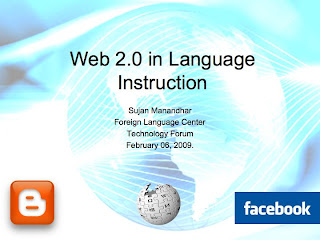 The learners – faculty and staff from the various language departments at the Ohio State University – were a very curious bunch with genuine desire to incorporate 2.0 facets along with a healthy dose of ‘how the heck will Facebook and MySpace help in my class?’ feeling. We dove into the intros and rise of Web 2.0 and some major pedagogy (heavy!) and looked into adding 2.0 aspects into the classroom. Blogs (with Blogger) and Wikis (with PB wiki) were the natural candidates for hands-on creation and we went into these with very little difficulty, with occasional questions. By the time we completed creating these, time was ticking away.
The learners – faculty and staff from the various language departments at the Ohio State University – were a very curious bunch with genuine desire to incorporate 2.0 facets along with a healthy dose of ‘how the heck will Facebook and MySpace help in my class?’ feeling. We dove into the intros and rise of Web 2.0 and some major pedagogy (heavy!) and looked into adding 2.0 aspects into the classroom. Blogs (with Blogger) and Wikis (with PB wiki) were the natural candidates for hands-on creation and we went into these with very little difficulty, with occasional questions. By the time we completed creating these, time was ticking away.Facebook and Myspace has some educational merits, but the returns seem minimal to me. I like the collaborative efforts these social networks provide, but long-term gain is debatable. I think video upload sites like Youtube certainly can be a strong educational tool as well. Podcasts and vodcasts are great tools for sure, but the efforts needed to create these are not small.
The bottom-line (as suspected) was that faculty are willing to learn and incorporate these tools into their curriculum, but time is a deterrent. Additional technical guidance and support can help pave the way for 2.0 in classrooms.
Technologies: Web 2.0, Blogs, Wikis, Social Networks, Podcasts, Video-sharing, Youtube, Facebook, Myspace.
Contact me:
Sujan Manandhar
Instructional Aids Associate,
Foreign Language Center
Ohio State University